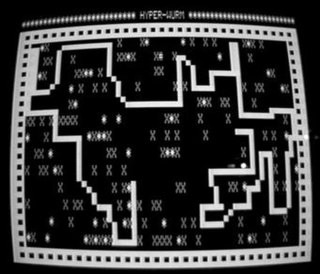
Snake is a video game genre where the player maneuvers a growing line that becomes a primary obstacle to itself. The concept originated in the 1976 two-player arcade game Blockade from Gremlin Industries, and the ease of implementation has led to hundreds of versions for many platforms. 1982's Tron arcade game, based on the film, includes snake gameplay for the single-player Light Cycles segment. After a variant was preloaded on Nokia mobile phones in 1998, there was a resurgence of interest in snake games as it found a larger audience.
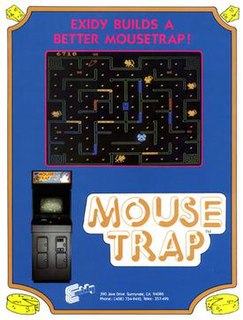
Mouse Trap is a 1981 arcade maze game developed by Exidy. The game design is similar to Pac-Man, replacing Pac-Man with a mouse, the dots with cheese, the ghosts with cats, and the energizers with bones. The unique elements of Mouse Trap are that color-coded doors in the maze can be toggled by pressing a button of the same color, there is a hawk that can fly across the maze, and the bones do not immediately power up the mouse but instead are activated by pressing a button.

Stargate is a side-scrolling shooter game released for arcades in 1981 by Williams Electronics. Created by Eugene Jarvis and Larry DeMar, it is a sequel to Defender which was released earlier in the year. It was the first of only three productions from Vid Kidz, an independent development house formed by Jarvis and DeMar.
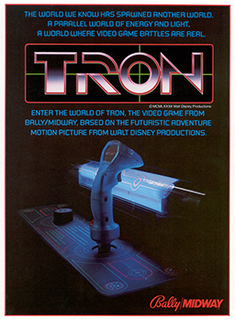
Tron is a coin-operated arcade video game manufactured and distributed by Bally Midway in 1982. The game consists of four subgames inspired by the events of the Walt Disney Productions motion picture Tron released earlier in the summer. The lead programmer was Bill Adams. The music programmer was Earl Vickers.
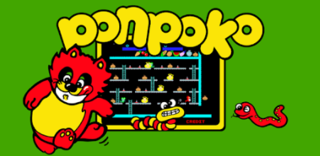
Ponpoko (ポンポコ) is a non-scrolling platform game developed and published by Sigma Enterprises. It was released in Japan in November 1982. The goal is to collect all of the fruits and vegetables in each level. Ponpoko was sold in North America by Venture Line as a conversion kit starting in January 1983.
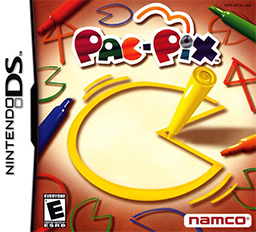
Pac-Pix (パックピクス) is a 2005 action video game in the Pac-Man series, developed and published by Namco for the Nintendo DS. It involves using the Nintendo DS's touchscreen to draw Pac-Men and guiding them to eat all the ghosts on each page by using various gestures.

Rattler Race is a snake video game, created in 1991 by Christopher Lee Fraley. It is similar to the 1982 apple-eating game Snake Byte, but with the addition of enemy snakes. It was distributed with the Microsoft Entertainment Pack 2, which was included with early Microsoft Windows systems. The player takes on the role of a hungry snake, who must eat all the apples in each level, whilst avoiding the hazards.
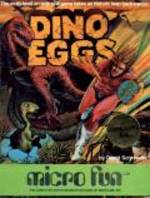
Dino Eggs is an Apple II platform game designed by David H. Schroeder and published by Micro Fun in 1983. It was ported to the Commodore 64 by Leonard Bertoni and the IBM PC as a self-booting disk. Dino Eggs is Schroeder's second published game, after Crisis Mountain.

Zuma is a 2003 tile-matching puzzle video game published by PopCap Games. It was released for a number of platforms, including PDAs, mobile phones, and the iPod.

Do! Run Run, also known as Super Pierrot, is the fourth and final incarnation of Mr. Do!, the Universal video game mascot. Returning to his Mr. Do! roots, the clown has a bouncing powerball with which to hurl at monsters. Mr. Do runs along the playfield picking up dots and leaving a line behind him, which the player is encouraged to create closed off sections with. Precariously balanced log traps can be rolled downslope, crushing enemies. The resulting game is somewhat of a cross between Mr. Do!, Congo Bongo, Pac-Man, and Qix.
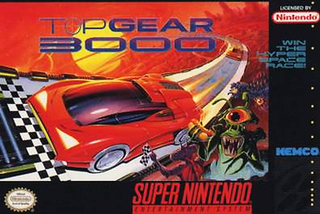
Top Gear 3000, later released in Japan as The Planet's Champ: TG3000, is a racing video game developed by Gremlin Interactive and published by Kemco for the Super Nintendo Entertainment System. It is the third game in the original Top Gear trilogy, and the last in the series to be developed by Gremlin. 3000 heavily resembles the previous Top Gear 2, but is set in the distant future.
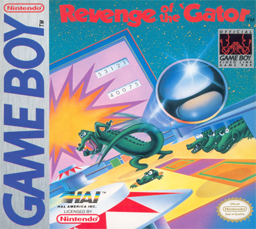
Revenge of the 'Gator, known in Europe as Pinball: Revenge of the Gator, is an alligator-themed pinball video game developed and published by HAL Laboratory. It was released for the original Game Boy in 1989/1990. The objective of the game is to score as many points as possible without having the player's pinball eaten by the gator.
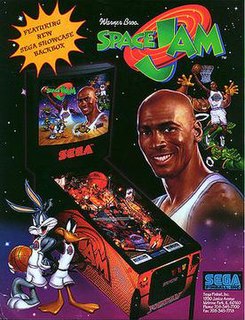
Space Jam is a 1996 pinball machine released by Sega Pinball. It is based on the film of the same name.
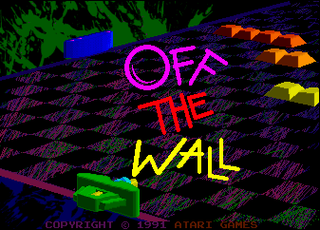
Off the Wall is an arcade game produced by Atari Games and released in North America in 1991. A remake of Breakout, it has a much wider variety of gameplay elements of the original. Most notably, it models spin on the ball. Off the Wall supports up to three players simultaneously. The game's graphics include many backgrounds modeled after modern abstract art.
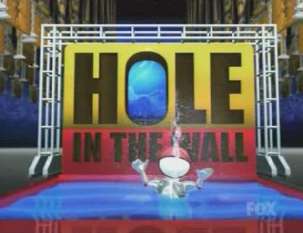
Hole in the Wall is an American game show that has aired in two versions on American television.
Tokyo Friend Park 2 is a Japanese game show that premiered in April 1994 on the Tokyo Broadcasting Station (TBS). TFP2 airs on Monday nights roughly from 6:55 - 7:54 JST in Japan.
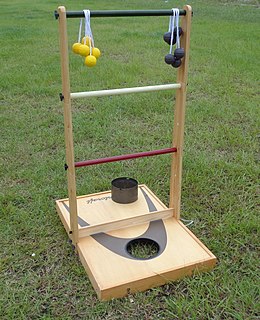
Ladder toss is a lawn game played by throwing bolas onto a ladder.

Ball Fighter is a puzzle video game developed by Teyon for the Nintendo DSiWare. It is available in the Nintendo DSi Shop for 500 Nintendo DSi Points.
Family Game Night was an American television game show based on Hasbro's family of board games and EA's video game franchise of the same name. The show was hosted by Todd Newton. Burton Richardson announced for the first two seasons, until he was replaced by Stacey J. Aswad for the third season, and then Andrew Kishino beginning in the fourth season. The 60-minute program debuted on October 10, 2010, on The Hub, formerly Discovery Kids. The network would become Discovery Family on October 13, 2014; it was previewed on October 9, 2010, on its sister channel, TLC. Seasons 1 and 2 each contained 26(1) and 30(2) episodes. Seasons 3, 4 and 5 each contained 15 episodes. Season two premiered on Friday, September 2, 2011, and additional games were added. The games added to the second season included Cranium Brain Breaks, Green Scream, Ratuki Go-Round, Simon Flash, Operation Sam Dunk, Trouble Pop Quiz, and Spelling Bee. However, games from the previous season were still kept.

















